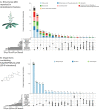The LOTUS initiative for open knowledge management in natural products research
- PMID: 35616633
- PMCID: PMC9135406
- DOI: 10.7554/eLife.70780
The LOTUS initiative for open knowledge management in natural products research
Abstract
Contemporary bioinformatic and chemoinformatic capabilities hold promise to reshape knowledge management, analysis and interpretation of data in natural products research. Currently, reliance on a disparate set of non-standardized, insular, and specialized databases presents a series of challenges for data access, both within the discipline and for integration and interoperability between related fields. The fundamental elements of exchange are referenced structure-organism pairs that establish relationships between distinct molecular structures and the living organisms from which they were identified. Consolidating and sharing such information via an open platform has strong transformative potential for natural products research and beyond. This is the ultimate goal of the newly established LOTUS initiative, which has now completed the first steps toward the harmonization, curation, validation and open dissemination of 750,000+ referenced structure-organism pairs. LOTUS data is hosted on Wikidata and regularly mirrored on https://lotus.naturalproducts.net. Data sharing within the Wikidata framework broadens data access and interoperability, opening new possibilities for community curation and evolving publication models. Furthermore, embedding LOTUS data into the vast Wikidata knowledge graph will facilitate new biological and chemical insights. The LOTUS initiative represents an important advancement in the design and deployment of a comprehensive and collaborative natural products knowledge base.
Keywords: LOTUS Initiative; Wikidata; computational biology; ecology; knowledge graph; linked data; natural products; open science; systems biology.
© 2022, Rutz et al.
Conflict of interest statement
AR, MS, JG, DM, EW, AG, JG, RS, RP, JV, CS, GP, JW, JB, PA No competing interests declared
Figures









References
-
- Afendi FM, Okada T, Yamazaki M, Hirai-Morita A, Nakamura Y, Nakamura K, Ikeda S, Takahashi H, Altaf-Ul-Amin M, Darusman LK, Saito K, Kanaya S. KNApSAcK family databases: integrated metabolite-plant species databases for multifaceted plant research. Plant & Cell Physiology. 2012;53:e1. doi: 10.1093/pcp/pcr165. - DOI - PubMed
-
- Allard PM, Bisson J, Rutz A. ISDB: In Silico Spectral Databases of Natural Products. Zenodo. 2021 doi: 10.5281/zenodo.5607264. - DOI
Publication types
MeSH terms
Substances
Grants and funding
LinkOut - more resources
Full Text Sources
Molecular Biology Databases

